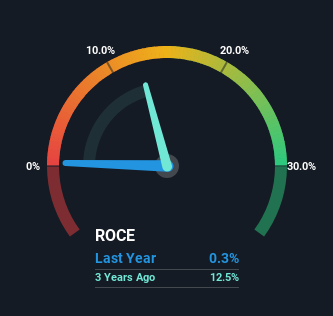- China
- /
- Construction
- /
- SZSE:301136
Investors Could Be Concerned With Fujian Tendering's (SZSE:301136) Returns On Capital

There are a few key trends to look for if we want to identify the next multi-bagger. In a perfect world, we'd like to see a company investing more capital into its business and ideally the returns earned from that capital are also increasing. Ultimately, this demonstrates that it's a business that is reinvesting profits at increasing rates of return. However, after investigating Fujian Tendering (SZSE:301136), we don't think it's current trends fit the mold of a multi-bagger.
Return On Capital Employed (ROCE): What Is It?
Just to clarify if you're unsure, ROCE is a metric for evaluating how much pre-tax income (in percentage terms) a company earns on the capital invested in its business. Analysts use this formula to calculate it for Fujian Tendering:
Return on Capital Employed = Earnings Before Interest and Tax (EBIT) ÷ (Total Assets - Current Liabilities)
0.0028 = CN¥4.5m ÷ (CN¥2.1b - CN¥524m) (Based on the trailing twelve months to March 2024).
So, Fujian Tendering has an ROCE of 0.3%. In absolute terms, that's a low return and it also under-performs the Construction industry average of 6.5%.
Check out our latest analysis for Fujian Tendering

While the past is not representative of the future, it can be helpful to know how a company has performed historically, which is why we have this chart above. If you'd like to look at how Fujian Tendering has performed in the past in other metrics, you can view this free graph of Fujian Tendering's past earnings, revenue and cash flow.
What The Trend Of ROCE Can Tell Us
On the surface, the trend of ROCE at Fujian Tendering doesn't inspire confidence. Over the last five years, returns on capital have decreased to 0.3% from 14% five years ago. Given the business is employing more capital while revenue has slipped, this is a bit concerning. This could mean that the business is losing its competitive advantage or market share, because while more money is being put into ventures, it's actually producing a lower return - "less bang for their buck" per se.
On a related note, Fujian Tendering has decreased its current liabilities to 25% of total assets. So we could link some of this to the decrease in ROCE. What's more, this can reduce some aspects of risk to the business because now the company's suppliers or short-term creditors are funding less of its operations. Some would claim this reduces the business' efficiency at generating ROCE since it is now funding more of the operations with its own money.
The Bottom Line On Fujian Tendering's ROCE
In summary, we're somewhat concerned by Fujian Tendering's diminishing returns on increasing amounts of capital. It should come as no surprise then that the stock has fallen 20% over the last year, so it looks like investors are recognizing these changes. That being the case, unless the underlying trends revert to a more positive trajectory, we'd consider looking elsewhere.
On a final note, we found 4 warning signs for Fujian Tendering (2 are potentially serious) you should be aware of.
While Fujian Tendering may not currently earn the highest returns, we've compiled a list of companies that currently earn more than 25% return on equity. Check out this free list here.
New: AI Stock Screener & Alerts
Our new AI Stock Screener scans the market every day to uncover opportunities.
• Dividend Powerhouses (3%+ Yield)
• Undervalued Small Caps with Insider Buying
• High growth Tech and AI Companies
Or build your own from over 50 metrics.
Have feedback on this article? Concerned about the content? Get in touch with us directly. Alternatively, email editorial-team (at) simplywallst.com.
This article by Simply Wall St is general in nature. We provide commentary based on historical data and analyst forecasts only using an unbiased methodology and our articles are not intended to be financial advice. It does not constitute a recommendation to buy or sell any stock, and does not take account of your objectives, or your financial situation. We aim to bring you long-term focused analysis driven by fundamental data. Note that our analysis may not factor in the latest price-sensitive company announcements or qualitative material. Simply Wall St has no position in any stocks mentioned.
Have feedback on this article? Concerned about the content? Get in touch with us directly. Alternatively, email editorial-team@simplywallst.com
About SZSE:301136
Fujian Tendering
Provides engineering supervision, test and inspection, surveying and mapping, geographic information, survey and design, and other engineering consulting services in China.
Adequate balance sheet minimal.
Market Insights
Community Narratives



